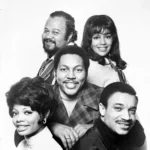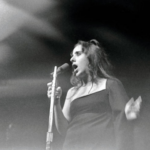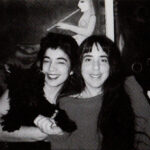Laura Nyro – “Hard To Get Into and Hard To Get Out Of”
Originally Posted on Blues For A Big Town Blog

“Sometimes I think being a star is kind of silly. I’d sooner be looked at like a comrade rather than a star”
Laura Nyro in an interview with Melody Maker in 1976 after re-surfacing from the first of two self imposed retirements from the music business
“The purist artist I’ve ever met in my life”
Felix Cavaliere, musician and co-producer of Nyro’s highly acclaimed album Christmas And The Beads Of Sweat
“I idolized her. The soul, the passion, the out and out audacity… like nothing I ever heard before”
Elton John, one of Laura Nyro’s many admirers
Truth be told, Laura Nyro’s work is hard to get into and hard to get out of.
I’ve always found Laura Nyro’s music somewhat unsettling. Even as a fan, there’s always an uneasiness when listening to her songs. Her compositions are too raw, too real. They’re a down to the bone chilling of emotions laid bare. And if that’s not enough, a number of her songs are delivered in pitch perfect multi octave banshee wailings against a backdrop of Nyro’s unique time changes and abrupt stream of consciousness detours.
In saying that, Laura Nyro is nothing short of captivating.
The listener can’t help taking notice because her renderings demand the utmost attention. This isn’t background music to be taken lightly. Rather, it’s thought provoking, highly inventive, and intelligent. It demands that the listener go back to a time when one actually sat down and gave the music their undivided attention – as opposed to having it serve as background while doing whatever mundane chores of the day. Finally, Laura Nyro simply deserves consideration.
To say that Laura Nyro had no aspirations to be a star is, if nothing else, a huge understatement.
A true original and brilliant composer; one would be hard pressed to name a worthy equal of her uncompromising talent. Her deeply personal statements that made her hard to categorize also endeared her to many.
Laura Nyro never had a Gold album or a hit single yet commanded a legion of ardent supporters comprised of both peers and devoted fans during her lifetime.
That dedication continues long after her passing in 1997. (Her only appearances on the charts were a Top 40 album (# 32) New York Tandeberry in 1969 and a pure New York Soul cover of The Drifters’ “Up On The Roof” that placed # 92 in 1970. The song was included on the album Christmas And The Beads Of Sweat.)
While that may be the case, it should be noted that although the general public may have not been familiar with Laura as a performer and recording artist during her time, they were certainly aware of some of her material that became hits for other artists.
For example, supper club Soul group, The 5th Dimension, built a career on Laura’s songs. Here’s a brief list, in no particular order, of her “second hand” songs heard on the radio.

“Stoned Soul Picnic” – The 5th Dimension
“Wedding Bell Blues” – The 5th Dimension
“Save The Country” – The 5th Dimension
“Sweet Blindness” – The 5th Dimension
“Stoney End” – Linda Ronstadt, Barbara Streisand
“Hands Off The Man (Flim Flan Man)” – Barbara Streisand
“Eli’s Comin’” – Three Dog Night
“And When I Die” – Blood sweat & Tears, Peter Paul & Mary
The covers would provide some awareness for Nyro;
(accepting that the listener bothered to find out the identity of the writer for any of the respective songs). A drawback to these versions is that they don’t convey the musicality, passion, and commitment of the Nyro originals. Coupled with that is that some of the interpreters of her work, (e.g. Three Dog Night), lacked credibility with “serious” music critics and some listeners. As a result, Nyro conceivably could be mistaken as a MOR, (Middle Of The Road), artist, (which plainly she was not).
Laura Nigro (birth name) was born in the Bronx in October 18, 1947 and was raised in an Italian – Jewish household.
Her father was a Jazz trumpeter and piano tuner; and her mother was a bookkeeper. Music was omnipresent in the house as Laura heard her father play for countless hours daily, and her mother played records by a wide spectrum of artists.
Through those records Laura was exposed to the likes of soprano Leontyne Price, Billie Holiday, Nina Simone, and composers Ravel and Debussy.
By her own admission Laura was not a particularly happy child; music as well as poetry served as her only refuge. Somewhat of a child prodigy Nyro was a self-taught pianist and began writing songs at eight years old. (She wrote the above mentioned “And When I Die” when she was 17).
As Laura entered her teenage years, she found a growing attraction to music from and on the street.
“When I was 16 years old, and used to go out and sing…the music was happening then; that’s when Trane was happening with Jazz, when Soul music and Girl Groups and everything was just really rich, and things were very open. I would go out singing, as a teenager, to a party or out on the street because there were harmony groups there, and that was one of the joys of my youth”
Laura Nyro
She would go on to say that singing on street corners soon became “an everyday occurrence”.
Jazz was Nyro’s first love; she cited Miles Davis and John Coltrane as early heroes and providers of inspiration.
A product of her inner-city environment, Nyro was receptive to all the musical experiences the city had to offer:
In addition, relating to her urban environment, Laura felt a kinship to the Blacks and Hispanics in her neighbourhood saying “I was brought up in a melting pot in New York with Spanish and Black people and I felt very close to those people”.
Thus she was provided a distillation of a personal musical direction – with shades of Jazz, Motown, Soul, New York R&B, Doo-Wop, and the ever prevalent Girl Groups – that both initiated and perpetuated her career. Adding another element to her work was her mother and paternal grandfather’s progressive mindset that shaped her outlook on life. Laura stated as such in an interview: “… I feel at home in the Peace Movement, and in the Women’s Movement, and that has influenced my music”.
Before honing skills that would set her apart from her contemporaries, Laura attended the High School Of Music & Art in Manhattan.
“Attended” is a term used loosely, in that fellow classmates recalled that she rarely went to class but made her presence felt nonetheless. She was remembered as a unique personality; making a Gothic statement in flowing black dresses, purple lipstick, and bright red nail polish. Added to the mystery is that she used a variety of surnames (settling on “Nyro” at the time of her discovery and subsequent first recording).
Nyro, who would record 15 albums in her 30 year career.
With 10 studio works (1 posthumously), and 5 live offerings (3 posthumously) Laura was already a seasoned performer when she recorded her first album at 19. One year previous she drew rave reviews in the course of her live debut in a 2 month stay at San Francisco’s bohemian The Hungry I. There, audiences caught a glimpse of her live performances that would prove to be fervent affairs as her career evolved.
That she was more than a novice prior to that first recording a performer is borne out by the fact that she had first rate songs ready to commit to tape including the aforementioned “And When I Die”, “Stoney End”, and “Wedding Bell Blues”. The album More Than A New Discovery was released in 1967 on the Verve Folkways label, (and re-released by Columbia in 1973 as The First Songs after they purchased the masters from Verve).
While selling moderately, the critically acclaimed first outing was a factor in Laura being invited to play The Monterey Pop Festival in 1967.

Slotted between The Byrds and The Jefferson Airplane on the Saturday evening, Nyro chose not to play piano during her set. Instead, she stood at the mic and sang, backed by a Soul band comprised of top Hollywood session players and 2 background singers.
Her set included “Wedding Bell Blues”, “Eli’s Comin’”, “Stoned Soul Picnic”, and “Poverty Train”. The stage shy Nyro felt out of her element to the point that she was convinced that she was shouted off stage; and, as a result, refused to be included in D. A. Pennabaker’s documentary. Her impression was later repeated many times as truth. But recovered footage of the documentary demonstrated that she was, at the very least, reasonably received.
One person who was suitably impressed with her performance was soon to be impresario David Geffen who would prove instrumental in her career.

It was Geffen, who, after freeing her from her existing recording and management contract, (that Nyro signed under age), subsequently signed her as his first client to a management contract, and brought her to the attention of Columbia Records. The Columbia contract offered Nyro full artistic freedom; she would stay with the label for 25 fruitful years.
(There’s a great story of Nyro’s audition for Columbia exec Clive Davis that underlines her eccentricity and quirky personality. The story goes that the audition took place in a hotel room. After Laura took a seat at the piano she said that she found the lighting upsetting; and insisted on performing with only the light of the muted TV in the room. Perfect.)
It was Geffen that managed to heighten her profile as a songwriter by getting other artists to record Laura’s songs.
He did so when he sensed that she was content to write and record and not get involved to the extent that was required to get established in the business. Geffen’s observation was that
“Laura lacked a certain level of ambition and really didn’t want to do the things that people do to become known. So I thought I’d better get people to record these songs and make them hits so that people will see that she’s a great songwriter”
David Geffen
It was also Geffen who started a music publishing company with Nyro – Tuna Fish Music – that they later sold to CBS for $4.5 million.
The transaction made Laura a millionaire at 21. (Geffen used his share to start Asylum Records with the hopes of having Nyro move from Columbia and sign with his new label. To his dismay, Nyro opted to remain at Columbia).
At Columbia, in the years 1968 through 1976, Laura made 5 albums in quick succession including a “trilogy” considered to be her finest moments:
- Eli And The Thirteenth Confession (1968)
- New York Tendaberry (1969)
- Christmas And The Beads Of Sweat (1970)
Of these “Eli” is the highest profile; it’s an autobiographical statement charting her journey from childhood to that of a mature woman. “Eli” contains two of Nyro’s best known songs: “Eli’s Comin’” and “Stoned Soul Picnic”.
New York Tendaberry is a darker, moodier account than its predecessor with no recognizable hits outside of “Save The Country” – an anti-war song that Nyro wrote after Robert Kennedy was assassinated. Although it may not be for general consumption the release is heralded by hardcore fans as a definitive statement.
Finally, Christmas And The Beads Of Sweat draws heavily of Nyro’s always superb songwriting filtered through her love of Jazz and R&B. The album is produced by Felix Cavaliere and Arif Mardin and boasts a dream cast of backing musicians including Muscle Shoals’ Swampers, Duane Allman, Felix Cavaliere, Dino Danelli, and a number of New York’s top session musicians. Standout titles include “When I Was A Freeport And You Were The Main Drag”, “Christmas In My Soul”, and Nyro’s sublime take on “Up On The Roof”.
In the midst of recording her “trilogy” Laura had become friends with the members of Blood Sweat & Tears.
After group founder Al Kooper left the collective – and before David Clayton Thomas joined – Laura apparently received an offer to join the group as the lead singer. Nyro was giving it serious consideration when Geffen convinced her otherwise. The thought of Nyro fronting BS&T is mind-boggling.)
The following year Nyro decided to record a particularly uncommercial covers album that paid tribute to the music of her childhood in the Bronx: predominantly Motown, Doo-Wop, and Girl Groups.
A personal favourite, Gonna Take A Miracle, was produced by the Philly Soul team of Gamble and Huff. The album features LaBelle – Patti LaBelle, Nona Hendrix, and Sarah Dash – backing Laura on selections including “I Met Him On A Sunday” (Girl Group / Doo-Wop, The Shirells 1958), “Spanish Harlem” (New York R&B, Ben E. King, 1961) and “Jimmy Mack” (Motown, Martha Reeves & The Vandellas, 1966). All 10 recordings are first takes and are delivered with joyous intensity.
Gonna Take A Miracle stands as an artistic achievement but didn’t fare well commercially.
The non-success may have played a role – and added to the strain of Nyro having to play the game – in Laura walking away from the business in 1971 at 24. She got married, (to carpenter and Vietnam vet David Bianchini), and moved to Danbury Connecticut. Although seemingly at peace and acclimating to the rural life, in 1975 Nyro had to endure the hardship of her mother passing away at 49 of ovarian cancer as well as the dissolution of her marriage. After her divorce was finalized, Nyro’s response was to try the music scene once again in1976.
Nyro’s return was to be short lived.

After the birth of a son in 1978 Nyro retreated once again. This time her retirement lasted until 1984. At that time Nyro started a relationship, (that would last for 17 years), with painter and artist Maria Desiderio, and meanwhile turned her attention musically to touring extensively. Both with a full band and on solo excursions, Nyro spent a good part of the 80’s and 90’s playing various venues resulting in 4 live recordings released during her lifetime. The most prominent of these is Laura: Live At The Bottom Line (1989) that finds Nyro fronting a full band playing a wide spectrum of her material.
In 1996, Nyro was on the west coast for a series of shows when she was diagnosed with ovarian cancer.
At the time of her diagnosis Laura, without a current label, partnered with a friend, Eileen Silver-Lilywhite, to form Luna Mist Records. While the two had their eyes on a number of ambitious projects for the label, work started on Angel In The Dark – the last music that Laura Nyro recorded. (The recording would stay on the shelf for more than 5 years before Scott Billington finally released it on the Rounder label in 2001).
Laura had been through two chemo sessions when they started recording.
As one might expect the record is masterful. Half of the songs are covers; some with just Laura on piano and others with a full band including John Tropea on guitar, Christopher Parker and Bernard Purdie on drums, and the Brecker Brothers on horns. Remarkably, given her state of health, Nyro is in great voice. Her takes on Smokey Robinson’s “Ooo Baby Baby” and Dionne Warwick’s “Walk On By” are particularly impressive.
In the liner notes Nyro describes herself as singing “Soul songs with Jazz phrasings”.
In keeping with that thought – and knowing that she inspired the likes of Rickie Lee Jones, Wendy Waldman, Suzanna Vega, and Kate Bush among others – I can’t help thinking, when hearing this last offering from Laura Nyro, that Cassandra Wilson is listening intently.
Laura Nyro passed away on April 8, 1997 at the age of 49 from ovarian cancer, (as her mother had before her). Adding further irony, Nyro’s former partner, Maria Desiderio would also die from ovarian cancer two years later.
Laura Nyro’s career was marked by letting her inspiration rather than commercial prospects guide her. The result of that inspiration were usually highly personal, dark and edgy offerings with Nyro always steadfastly remaining true to her art.
Laura Nyro was inducted into The Songwriters Hall Of Fame in 2010 and The Rock & Roll Hall Of Fame in 2012. Both inductions were well deserved.
Rico Ferrara, May 2022

Thank you Rico for your lovely article on Laura Nyro. She is my favorite female artist bar none. In the early 1970s Nyro’s albums and performances were reckless, wild, complex and unique; it was impossible to explain what her sound was like. She often sang anthems adopted by feminists and LGTBQ+ such as Sanda Berhardt. Your article has inspired me to revive that music in my own listening!